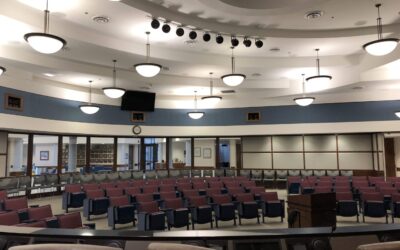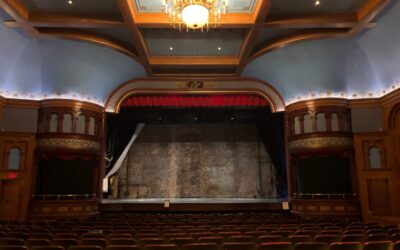Norman residents with hearing loss can now participate with ease in Norman City Council meetings Citizens with hearing loss in the city of Norman, Oklahoma can now hear better in city council meetings thanks to the installation of a hearing loop system! The city...
Hearing Loops For Churches
In a similar way these are the ones on whom seed was sown on the rocky places, who, when they hear the word, immediately receive it with joy.
– Mark 4:16

Large rooms with many hard surfaces like churches are not “hearing friendly”. Even with the best, most expensive sound system, reverberation and ambient noise are huge problems for those with hearing loss. Hearing Loops provide users with a clear sound by removing these distractions and enhancing clarity, as well as amplification, directly to the user’s ear.
Loop users describe the sound through a hearing loop as similar to the sound coming from inside their own heads! The loop literally turns the microphone at the lectern or podium into the microphone on a user’s hearing aid. No headset or receiver is required for hearing aids with a t-coil, as the t-coil acts as a receiver for the user!
Adding a hearing loop to a church has been shown to bring back members that have quit going to church because they cannot hear. There are also many individuals that attend worship services, but get nothing from it because they cannot understand what is being said. And many hard of hearing spouses accompany their loved one to services only to sit there and not understand what is being said. A hearing loop can be a vital piece of the church’s ministry.

What Does a Hearing Loop Cost?
The cost of installing a hearing loop in a place of worship varies greatly depending on size, flooring, configuration, seating, construction of floor, floor coverings and other considerations. Hearing loop costs generally range from $4,500 to 25,000 in a sanctuary. To put that cost in perspective – consider that a good set of hearing aids typically costs $6,000 to $10,000!
Assist2Hear works with houses of worship to keep costs down for each congregation. Ask us how your congregation can be utilized to help keep costs low. On-site hearing loop demonstrations are also great ways to raise funds!
FM Systems Versus Hearing Loops
Many churches attempt to meet hearing access needs through FM systems, which are often ignored by congregation members due to the requirement of a headset/receiver. The sound quality from a hearing loop is considered to be exceptional to FM systems, as FMs just amplify sound versus a hearing loop, which enhances clarity as well as volume. A hearing loop has limitless users, whereas an FM system is limited to the number of receivers purchased. Loops take advantage of the user’s own hearing aids, which are set for their own hearing loss, versus the receiver of an FM system which is standardized.
“The fundamental question, disability activists say, is less what is in your congregational budget than what is in your heart,” writes Mark Pinsky in a 2011 USA Today article on hearing loss.
Recent Articles
Johnstown United Methodist Church Installs a Hearing Loop
Another Methodist Church Gets in the Loop! Assist2Hear is pleased to announce that yet another United Methodist church has chosen to install a hearing loop! This past Easter Sunday, congregation members with hearing loss at the United Methodist Church of Johnstown got...
New Colorado Hearing Loop: Wheeler Opera House
Historic Wheeler Opera House in Aspen, Colorado Installs Hearing Loop System Assist2hear is excited to announce the final completion of another new Colorado hearing loop installation at the Wheeler Opera House in Aspen, Colorado. The installation includes...
Hearing Loops in New Oklahoma City Catholic Church
Hearing Loops at New Catholic Shrine Site Oklahoma Catholics with hearing loss will have the best sound in the house when they worship at the Blessed Stanley Rother Shrine next year. The site will house a 2,000 seat Catholic church, the largest in Oklahoma, as well...
Parker Evangelical Presbyterian Church Installs a Hearing Loop
People with hearing loss have the best sound in the house at Parker Presbyterian! Parker Evangelical Presbyterian Church in Parker, Colorado recently installed a hearing loop, making it the most recent church in Colorado to "get in the loop". Congregation members...
Lakewood Cultural Center Debuts Hearing Loop
The Lakewood Cultural Center's post-pandemic performance debut tonight consists of a Jazz-age musical comedy, The Drowsy Chaperone, and a newly installed hearing loop system. The hearing loop system will allow theater attendees to clearly and crisply hear the dialogue...




